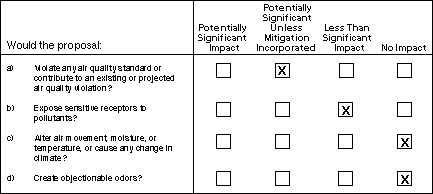V. AIR QUALITY

- Construction activities would
temporarily increase particulate concentrations in and
around the project site. The site has been previously
graded so that it is essentially flat, with a gentle
slope. Equipment and vehicles would generate dust during
clearing and excavation. Construction vehicle traffic on
unpaved surfaces would generate dust, as would wind
blowing over exposed earth.
It is not possible to accurately estimate the particulate
concentrations that would occur at or adjacent to the
construction site because such concentrations are very
sensitive to local meteorology and topography and to
variations in soil, silt, and moisture content.
Construction is proposed to begin in autumn, which is
generally the time of year when the soil has its lowest
moisture content. The first rains of the season typically
are received by mid-to late October, after which time,
the potential for substantial dust generation drops off.
However, dust generation can occur at any time during
construction, including during the rainy season.
If appropriate Bay Area Air Quality Management District
(BAAQMD) mitigation measures are implemented, no
significant impacts would be associated with construction
emissions. Dust is comprised of large particles
(i.e., larger than 10 microns in diameter)
which settle out rapidly on nearby horizontal surfaces
and are easily filtered by human breathing passages. Much
of the dust generated by construction is, therefore, of
concern more as a soiling nuisance rather than for its
unhealthful impacts. The remaining fraction of small
particulates might be sufficient to violate the state
24-hour average PM-10 standard in the vicinity of
construction. Unless mitigation measures were
implemented, elevated levels of PM-10 would occur
throughout periods of project construction. Because
residences are located immediately downwind of the
project site, mitigation measures would be necessary.
Because the project site is currently used as a staging
area for PG&E tree trimming operations, the
relocation of those activities and development of the
site as an unstaffed substation would result in a net
reduction of motor vehicle trips accessing the project
site. This would be a beneficial impact on long term
local concentrations of carbon monoxide. No relocation
site for the tree trimming trucks has yet been
established, but relocation would be unlikely to have a
substantial effect on regional pollutant emissions, as
most of the truck trips would continue to be regional in
nature (i.e., trip lengths would not be substantially
different).
Not considering actions that could be taken by PG&E
customers in the absence of the proposed project, it
could allow the delivery of electricity that would
otherwise not be generated and transmitted. Approximately
40 percent of California's electricity is generated by
coal, oil, natural gas, or organic matter, the combustion
of which results in air pollutant emissions.
Fuel-combustion power plants serving California could
increase production to deliver the electricity demand
facilitated by the proposed substation. It is not
possible to predict which power plants may specifically
be the source of power to support this increase.
Individual fossil fuel plant power generation, as
measured by megawatt output or capacity factors, has
varied substantially from year to year, largely as a
function of weather and hydroelectric power availability,
relative fuel costs and unscheduled plant outages.
Although generation patterns may shift among PG&Es
power plants, the generation from specific plants may
decline if out-of-state power penetrates the California
market to a greater extent than at present. Under the
restructuring of public electric utilities in California,
power generation from out-of-state plants may increase.
On the other hand, if electric loads grow in the absence
of new generation, in-state power plants could increase
generation, with commensurate increases in air emissions.
However, these emissions could be generated in any of the
air districts within California, or even from out of
state. Thus, the air quality effects related to power
generation in general are speculative and the latter do
not equate to effects on transmission. The project itself
would not induce demand for generation of additional
electricity.
Mitigation
The following mitigation measure
would reduce the potential impact of dust generation to a
less-than-significant level:
Mitigation Measure V.a-1: PG&E
shall require construction contractors to implement a dust
abatement program during construction activities. At a minimum,
the dust abatement program should include (as adapted from Bay
Area Air Quality Management District):
- Water all active
construction sites at least twice daily on days
without measurable rainfall at the site;
- Cover all trucks hauling
soil, sand, and other loose materials or
require all trucks to maintain at least two feet of
freeboard; and
- Sweep daily (with water
sweepers) all paved access roads including the
outside lane of Winchester Boulevard within one block
of the driveway access point, parking areas and
staging areas at construction sites.
- As discussed in the response
to item V.a, construction dust emissions could have a
temporary impact on nearby residences. Residences
occupied by very young children or the infirm could be
considered sensitive receptors. However, the impact to
these residences would likely be a nuisance impact of
larger particle dust settling and not an impact related
to a violation of PM-10 standards at the residences.
Existing trees would intercept some of the dust before
reaching the residences. With implementation of the above
cited mitigation measure V.a-1, this impact would be less
than significant.
- The proposed substation would
not be a source of thermal emissions and would not
represent the type of operation that could cause
alteration of air movement, moisture, or temperature, or
cause any change in climate. Therefore, there would be no
impacts related to climate change.
- The proposed substation is
not the type of operation identified by the BAAQMD as a
typical odor source (BAAQMD, 1996). The project would not
result in an odor-related impact.
TOP

